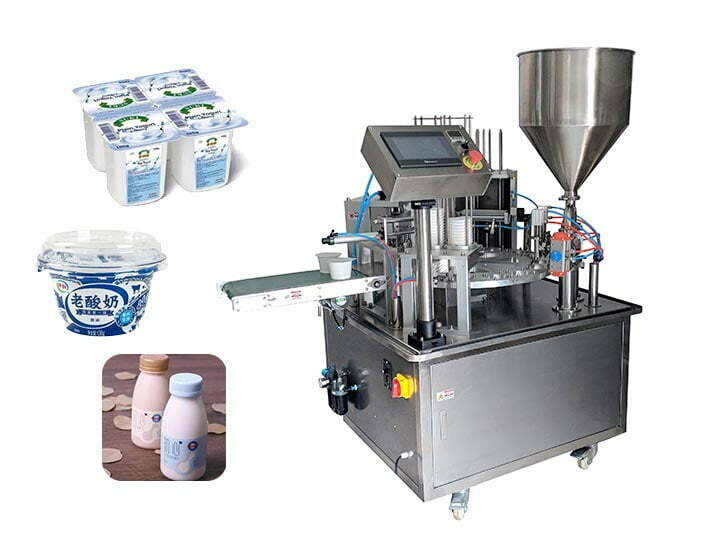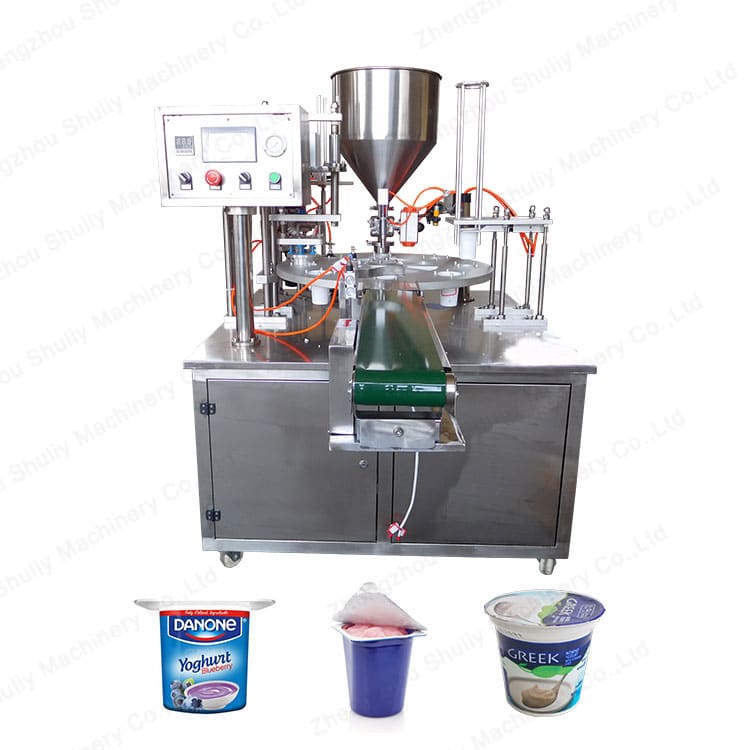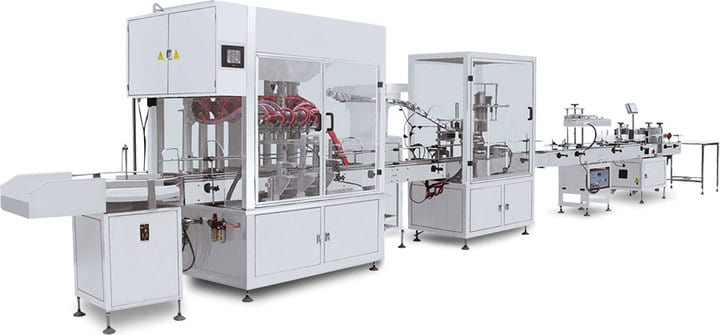Υπάρχουν όλο και περισσότερες ποικιλίες γαλακτοκομικών προϊόντων και η οργανωτική δομή και η σύνθεση κάθε τύπου δεν είναι η ίδια. Επομένως, για διαφορετικές ποικιλίες, πρέπει να επιλέγονται διαφορετικές μέθοδοι συσκευασίας γιαουρτιού για να διατηρηθεί η γεύση τους. Παρακάτω παρουσιάζονται συνοπτικά οι μέθοδοι συσκευασίας αρκετών γαλακτοκομικών προϊόντων:
Μέθοδοι συσκευασίας γιαουρτιού
Το γιαούρτι είναι ένα προϊόν γάλακτος που λαμβάνεται με ζύμωση φρέσκου γάλακτος ή γάλακτος σε σκόνη μέσω βακτηρίων γαλακτικού οξέος σε θερμοκρασία 40°C-45°C έως ότου η τιμή του pH του ζυμωμένου προϊόντος φτάσει στο 3,5-5,0 και στη συνέχεια ψύξη για να τερματιστεί η ζύμωση. Αυτό το είδος φαγητού είναι νόστιμο και θρεπτικό και η μακροχρόνια κατανάλωση βοηθά στην πέψη και τονώνει το στομάχι. Διάφορα γλυκαντικά, σταθεροποιητές, χυμοί φρούτων ή άλλοι αρωματικοί αρωματικοί παράγοντες μπορούν να προστεθούν πριν από τη συσκευασία για να παρασκευαστεί γιαούρτι με διαφορετικές γεύσεις. Με την πρόοδο των μεθόδων και του εξοπλισμού συσκευασίας και τη συνεχή εμφάνιση νέων υλικών συσκευασίας, υπάρχουν όλο και περισσότεροι τύποι προϊόντων γιαουρτιού και ορισμένα προϊόντα διαφέρουν πολύ σε τεχνολογία και υλικά συσκευασίας.
Ζυμωμένο γιαούρτι
Το ζυμωμένο γιαούρτι αναφέρεται στην προσθήκη σακχαρόζης ή γλυκαντικού στο νωπό γάλα, στη συνέχεια στην αποστείρωση και στη συνέχεια στον εμβολιασμό των καλλιεργημένων στελεχών βακτηρίων γαλακτικού οξέος στο νωπό γάλα, ζύμωση για 2 ώρες σε θερμοκρασία 40 ℃ ~ 45 ℃, έτσι ώστε η τιμή του pH να φτάσει το 3,5 -5.0, και στη συνέχεια το βάζετε στην ψυχρή αποθήκευση και ζυμώνετε το προϊόν. Αυτό είναι το πιο παραδοσιακό προϊόν γιαουρτιού. είναι δημοφιλές εδώ και πολλά χρόνια και αγαπιέται βαθιά από τον κόσμο. Ωστόσο, η αποθήκευση και η πώληση αυτού του γιαουρτιού πρέπει να πραγματοποιείται σε συνθήκες ψύξης, διαφορετικά τα βακτήρια γαλακτικού οξέος στο γιαούρτι θα συνεχίσουν να αναπτύσσονται, θα μολυνθούν εύκολα με μούχλα ή θα αποσυντεθούν σε άλλα προϊόντα.
Η συσκευασία του γιαουρτιού που έχει υποστεί ζύμωση περιλαμβάνει κυρίως γυάλινα μπουκάλια, πορσελάνινα μπουκάλια, πλαστικές σύνθετες μεμβράνες και πλαστικά κύπελλα. Τα γυάλινα μπουκάλια και τα πορσελάνινα μπουκάλια συνήθως τυλίγονται και σφραγίζονται με χαρτί κεριού, το οποίο είναι εύκολο στη χρήση. Ωστόσο, λόγω προβλημάτων όπως η υψηλή ποιότητα, η εύκολη ζημιά, η δυσκολία στην ανακύκλωση και η δυσκολία καθαρισμού, ορισμένοι κατασκευαστές χρησιμοποιούν σύνθετες μεμβράνες διπλής στρώσης και πλαστικά κύπελλα για τη συσκευασία του γιαουρτιού για να ξεπεράσουν τα παραπάνω προβλήματα. Ωστόσο, πρέπει να πωληθεί και να αποθηκευτεί σε χαμηλή θερμοκρασία και η διάρκεια ζωής είναι μόνο 7 ημέρες στους 4°C.

Μέθοδοι συσκευασίας αποστειρωμένου ζυμωμένου γιαουρτιού
Προκειμένου να λυθεί το πρόβλημα αποθήκευσης του γιαουρτιού που έχει υποστεί ζύμωση, οι άνθρωποι έχουν αναπτύξει αποστειρωμένο ζυμωμένο γιαούρτι. Για το γιαούρτι που έχει υποστεί ζύμωση, προσθέστε μια ορισμένη ποσότητα γιαουρτιού που έχει υποστεί ζύμωση για να σταθεροποιήσετε τη συνοχή του δυνατού γιαουρτιού. στη συνέχεια ομογενοποιήστε, κονσερβοποιήστε το ομογενοποιημένο προϊόν, πιέστε το και τέλος βάλτε το στο ψυγείο στους 4℃-6℃24 Ένα είδος αποστειρωμένου γιαουρτιού φτιαγμένο σε ώρες. Η συνοχή και η γεύση αυτού του προϊόντος δεν είναι μόνο καλύτερη από το συνηθισμένο γιαούρτι, αλλά και δεν χρειάζεται να αποθηκευτεί κατεψυγμένο. Μπορεί να αποθηκευτεί για 6 μήνες σε κανονική θερμοκρασία χωρίς βακτήρια ή άλλη υποβάθμιση.
Τα υλικά συσκευασίας του αποστειρωμένου γιαουρτιού που έχει υποστεί ζύμωση πρέπει να αντέχουν σε υψηλές θερμοκρασίες και να έχουν καλές ιδιότητες φραγμού. Τα περισσότερα αποστειρωμένα και ζυμωμένα γιαούρτια συσκευάζονται σε σακούλες από σύνθετο φιλμ, οι οποίες χωρίζονται σε δύο τύπους: τετράγωνες σακούλες και σακούλες μαξιλαριού. Τα τελευταία χρόνια, λευκά πλαστικά πλαστικά κύπελλα από πολυστυρένιο κατασκευασμένα με θερμοδιαμόρφωση και τέντωμα έχουν χρησιμοποιηθεί για τη συγκράτηση του γιαουρτιού που έχει υποστεί ζύμωση και σφραγίζονται με σύνθετα υλικά από φύλλο αλουμινίου με θερμοσφράγιση υψηλής συχνότητας. Αυτό το είδος διακόσμησης συσκευασίας είναι εξαιρετικά σχεδιασμένο, αεροστεγές και στεγανό μετά τη θερμική σφράγιση.
Οξινό ρόφημα γάλακτος
Η χρήση αποβουτυρωμένου γάλακτος ως πρώτης ύλης μπορεί να παραχθεί μια ποικιλία οξινισμένων ροφημάτων γάλακτος. Είναι γενικά πόσιμο με νερό ή ανθρακούχο νερό πριν το πιείτε, και είναι καλύτερο να το πίνετε αμέσως μετά την αραίωση. Εάν αποθηκευτεί για πολύ μεγάλο χρονικό διάστημα μετά την αραίωση, θα σημειωθεί καθίζηση πρωτεΐνης γάλακτος. Μετά από ζύμωση με αποβουτυρωμένο γάλα, προσθήκη ζάχαρης, νερού και μπαχαρικών και μετά ομογενοποίηση υπό υψηλή πίεση, το ρόφημα οξινισμένου γάλακτος που παρασκευάζεται με στιγμιαία αποστείρωση εξαιρετικά υψηλής θερμοκρασίας δεν είναι μόνο κατάλληλο για συνοχή και νόστιμο, αλλά μπορεί να πιει απευθείας χωρίς προσθήκη νερού και ανθρακούχο νερό όταν πίνεται. Επιπλέον, η πρωτεΐνη σε αυτό το ρόφημα γάλακτος είναι ομοιόμορφα διασκορπισμένη και έχει μεγάλη διάρκεια ζωής. Το όξινο ρόφημα γάλακτος είναι ένα προϊόν που εμφανίστηκε μόλις τα τελευταία χρόνια, επομένως η συσκευασία του περιλαμβάνει κυρίως σύνθετες εύκαμπτες σακούλες συσκευασίας, πλαστικά κύπελλα σφραγισμένα με αλουμινόχαρτο ή σύνθετα υλικά από φύλλο αλουμινίου και σύνθετα χαρτοκιβώτια. Τα σύνθετα υλικά που χρησιμοποιούνται στη σύνθετη εύκαμπτη σακούλα συσκευασίας περιλαμβάνουν PT/PVDC/PE, BOPP/PVDC/PE, NY/PVDC/PE και σύνθετο φύλλο αλουμινίου κ.λπ. το πλαστικό κύπελλο είναι ένα κύπελλο πολυστυρενίου κατασκευασμένο από λευκό πλαστικό με θερμοδιαμόρφωση και τέντωμα. Σφραγίζεται με θερμοσφράγιση υψηλής συχνότητας με σύνθετο υλικό από φύλλο αλουμινίου. το υλικό του σύνθετου χαρτοκιβωτίου είναι χαρτόνι με πλαστική επικάλυψη, κυρίως σύνθετο χαρτόνι τριών στρώσεων πολυαιθυλενίου/πολυαιθυλενίου.
Μέθοδοι συσκευασίας ανάμειξης ροφημάτων γιαουρτιού
Η ανάμειξη ροφημάτων γιαουρτιού αναφέρεται στην απευθείας προσθήκη νερού, γλυκαντικών, ξινών παραγόντων, σταθεροποιητών και αρωματικών παραγόντων στο νωπό γάλα ή στο αποβουτυρωμένο γάλα σε σκόνη χωρίς ζύμωση, ορισμένα προϊόντα προσθέτουν επίσης βιταμίνη Α ή βιταμίνη D και ορισμένα προϊόντα προσθέτουν ασβέστιο Ο παρασκευασμένος πολτός πρέπει να ομογενοποιηθεί υπό υψηλή πίεση, κονσερβοποιούνται και σφραγίζονται, και στη συνέχεια υποβάλλονται σε επεξεργασία στιγμιαίας αποστείρωσης εξαιρετικά υψηλής θερμοκρασίας και τέλος ψύχεται για να γίνει το προϊόν. Αυτό το είδος προϊόντος έχει εύλογη ανάμειξη θρεπτικών ουσιών, καλή γεύση και μεγάλη διάρκεια ζωής και είναι ιδιαίτερα αγαπητό από τους καταναλωτές, ειδικά από τα παιδιά και τους εφήβους.
Η συσκευασία του ροφήματος ανάμεικτου γιαουρτιού είναι η ίδια με τη συσκευασία του οξινισμένου ποτού και περιλαμβάνει επίσης τρεις τύπους σύνθετων εύκαμπτων σακουλών συσκευασίας, πλαστικά κύπελλα (μπουκάλια) και σύνθετα χαρτοκιβώτια.

Κρέμα και μαργαρίνη
Η διαδικασία παρασκευής της κρέμας είναι σχετικά απλή, δηλαδή, η κρέμα που λαμβάνεται με φυγοκεντρικό διαχωρισμό εξουδετερώνεται με την προσθήκη γάλακτος ασβέστη ή ανθρακικού νατρίου για να διατηρηθεί η τιμή του pH περίπου στο 6,4 έως 6,8, στη συνέχεια αποστειρώνεται και ψύχεται. Μείνετε σε χαμηλή θερμοκρασία 2°C-10°C για ένα ορισμένο χρονικό διάστημα για να προωθήσετε το μετά το μαγείρεμα της κρέμας, στη συνέχεια ανακατέψτε και, τέλος, πραγματοποιήστε διαδικασίες όπως το πάτημα. Η περιεκτικότητα σε λίπος του βουτύρου και της μαργαρίνης είναι πολύ υψηλή, η οποία μπορεί να φτάσει περίπου το 80%-83% και η περιεκτικότητα σε υγρασία είναι μικρότερη από 16%, επομένως είναι εύκολο να οξειδωθεί και να αλλοιωθεί και είναι εύκολο να απορροφηθεί η περίεργη μυρωδιά στο περιβάλλον . Ως εκ τούτου, οι κύριες απαιτήσεις των υλικών συσκευασίας είναι οι εξαιρετικές ιδιότητες φραγμού αερίων, η στεγανότητα από το οξυγόνο, η στεγανότητα του αρώματος και η άοσμη.
Η κρέμα και η μαργαρίνη συσκευάζονται παραδοσιακά σε γυάλινες φιάλες και δοχεία πολυαιθυλενίου και σφραγίζονται με σύνθετα υλικά AL/PE. Οι γενικές μέθοδοι συσκευασίας του γιαουρτιού μπορούν να τυλιχτούν με λαδόχαρτο, λαδόχαρτο, αλουμινόχαρτο/χαρτί θειικού οξέος ή σύνθετα υλικά αλουμινόχαρτου/λαδιόχαρτου. Το βούτυρο και η μαργαρίνη σε κουτί συσκευάζονται γενικά σε μικρά κουτιά από χαρτόνι με πλαστική επικάλυψη ή σύνθετα υλικά αλουμινίου και φύλλου. Διάφορα πλαστικά κουτιά που είναι δημοφιλή πρόσφατα κατασκευάζονται από PVC, PS, ABS και άλλα φύλλα μέσω διαδικασιών θερμοδιαμόρφωσης, και μερικά συσκευάζονται σε συνεξωθημένα πλαστικά κιβώτια και χάρτινα/πλαστικά σύνθετα κουτιά. Το καπάκι του κουτιού είναι γενικά κατασκευασμένο από πλαστικό PVC και μπορεί να προστεθεί ένα στρώμα χαρτιού για να διακοσμήσει το κουτί.
Μέθοδοι συσκευασίας τυριού κότατζ
Το τυρί είναι ένα γαλακτοκομικό προϊόν που παρασκευάζεται με πήξη του νωπού γάλακτος με πυτιά ή πεψίνη και στη συνέχεια επεξεργασία, σχηματισμό και ζύμωση του θρόμβου για να ωριμάσει. Το τυρί έχει υψηλή θρεπτική αξία, το οποίο είναι πλούσιο σε πρωτεΐνες, λιπαρά, ασβέστιο, φώσφορο, θείο και άλλα άλατα, καθώς και ποικιλία βιταμινών και έχει υψηλό ρυθμό πέψης και απορρόφησης.
Είτε είναι φρέσκο τυρί είτε επεξεργασμένο, πρέπει να είναι αεροστεγώς συσκευασμένο. Η συντήρηση του τυριού γίνεται κυρίως για την πρόληψη της μούχλας και του τάγγισης, ακολουθούμενη από τη διατήρηση της υγρασίας για τη διατήρηση του εύκαμπτου ιστού του και την αποφυγή απώλειας βάρους. Το τυρί συσκευάζεται σε λιωμένη κατάσταση, εκκενώνεται και γεμίζεται με άζωτο, έτσι ώστε να μπορεί να αποθηκευτεί για μεγάλο χρονικό διάστημα, αλλά αυτό απαιτεί το υλικό συσκευασίας να μπορεί να αντέχει σε υψηλές θερμοκρασίες ώστε να μην μαλακώσει και να παραμορφωθεί όταν το λιωμένο πολτός εγχέεται. Το πολυπροπυλένιο έχει καλή αντοχή στη θερμότητα και μπορεί να διατηρήσει την αντοχή του πάνω από 120°C. Το άκαμπτο κουτί από φύλλο πολυπροπυλενίου είναι κατάλληλο για τη γέμιση τυριού.
Η πλαστική μεμβράνη μονής στρώσης έχει κακή διαπερατότητα, αναπνέει εύκολα, οξυγόνο και δεν είναι ανθεκτική στη θερμότητα. Είναι εύκολο να σπάσει και να προκαλέσει ρύπανση του προϊόντος. Το τυρί συσκευασμένο σε μεμβράνη μονής στρώσης μπορεί να αποθηκευτεί μόνο για μικρό χρονικό διάστημα, αλλά η τιμή του είναι φθηνή. Συνήθως χρησιμοποιούνται PE, PVC, PVDC, E-VA, NY, κ.λπ. Συσκευασία θερμοσυστελλόμενης χρησιμοποιείται συχνά για την εξάλειψη του οξυγόνου στη σακούλα.
Η ευέλικτη μέθοδος συσκευασίας φρέσκου τυριού και τυριού πρέπει να χρησιμοποιεί σύνθετα υλικά. Συνήθως χρησιμοποιούνται PT/PVDC/PE, PET?PE, BOPP/PVDC/PE, NY/PVDC/PE, σύνθετο φύλλο αλουμινίου και προϊόντα χαρτιού με πλαστική επικάλυψη, ενώ χρησιμοποιείται κυρίως η συσκευασία κενού.
Συμπυκνωμένο γάλα
Το συμπυκνωμένο γάλα χωρίζεται σε δύο τύπους: το ζαχαρούχο γάλα και το μη επεξεργασμένο γάλα. Η διαδικασία παραγωγής των δύο δεν είναι η ίδια. Στο πρώτο, η σακχαρόζη προστίθεται στο επεξεργασμένο νωπό γάλα, στη συνέχεια προθερμαίνεται για αποστείρωση, συμπύκνωση υπό κενό και μπορεί να σφραγιστεί απευθείας μετά την ψύξη. Στο τελευταίο, το νωπό γάλα προθερμαίνεται απευθείας, αποστειρώνεται, συμπυκνώνεται υπό κενό και ομογενοποιείται χωρίς προσθήκη σακχαρόζης. Μετά την ψύξη, τα δοχεία γεμίζονται και σφραγίζονται, και στη συνέχεια αποστειρώνονται και ανακινούνται για δεύτερη φορά, και τέλος, λαμβάνεται το τελικό προϊόν.
Η περιεκτικότητα σε σακχαρόζη στο ζαχαρούχο προϊόν γάλακτος είναι 40%-45% και η ωσμωτική πίεση αυξάνεται μετά την προσθήκη της ζάχαρης και το τελικό προϊόν είναι προικισμένο με δυνατότητα συντήρησης. Το ζαχαρούχο γάλα χρησιμοποιείται κυρίως ως πρώτη ύλη για την επεξεργασία ποτών και τροφίμων. Το συμπυκνωμένο γάλα αποστειρώνεται με υψηλές θερμοκρασίες και η βιταμίνη Β1 χάνεται. Τα άλλα συστατικά διατηρούνται καλά. Η θρεπτική αξία είναι σχεδόν ίδια με αυτή του φρέσκου γάλακτος. Μετά από επεξεργασία υψηλής θερμοκρασίας, μετατρέπεται σε μαλακό τυρόγαλα, το οποίο πήζει από το οξύ του στομάχου ή την πυτιά στο ανθρώπινο σώμα. Εξαιρετικά απαλό και εύπεπτο. Επιπλέον, το λίπος ομογενοποιείται για να γίνουν τα σφαιρίδια του λίπους λεπτότερα και ευκολότερα απορροφήσιμα. Χρησιμοποιείται κυρίως για τη διατροφή των μωρών και μπορεί επίσης να χρησιμοποιηθεί ως ρόφημα για την παρασκευή καφέ ή μαύρου τσαγιού.
Η αποθήκευση του συμπυκνωμένου γάλακτος γίνεται κυρίως για την πρόληψη της μόλυνσης κοινών μικροοργανισμών όπως η μούχλα. Επομένως, εκτός από την επιλογή των κατάλληλων υλικών συσκευασίας, ο υπολειπόμενος αέρας στο δοχείο συσκευασίας θα πρέπει επίσης να αφαιρείται και να σφραγίζεται υπό κενό. Επί του παρόντος, τα μεταλλικά δοχεία χρησιμοποιούνται κυρίως για συσκευασία. Ο χώρος πλήρωσης και τα δοχεία πρέπει να απολυμαίνονται αυστηρά. Είναι καλύτερο να χρησιμοποιείτε μια αυτόματη μηχανή πλήρωσης για πλήρωση και σφράγιση με μια μηχανή στεγανοποίησης κενού για να αφαιρέσετε όσο το δυνατόν περισσότερο τον αέρα στο διάκενο της κεφαλής. Η θερμοκρασία αποθήκευσης του ζαχαρούχου γάλακτος δεν πρέπει να είναι μεγαλύτερη από 15°C. Μετά από στιγμιαία αποστείρωση σε εξαιρετικά υψηλή θερμοκρασία, το εβαπορέ γάλα μπορεί να αποθηκευτεί σε θερμοκρασία δωματίου. Η διάρκεια ζωής είναι περίπου 1 έτος.
